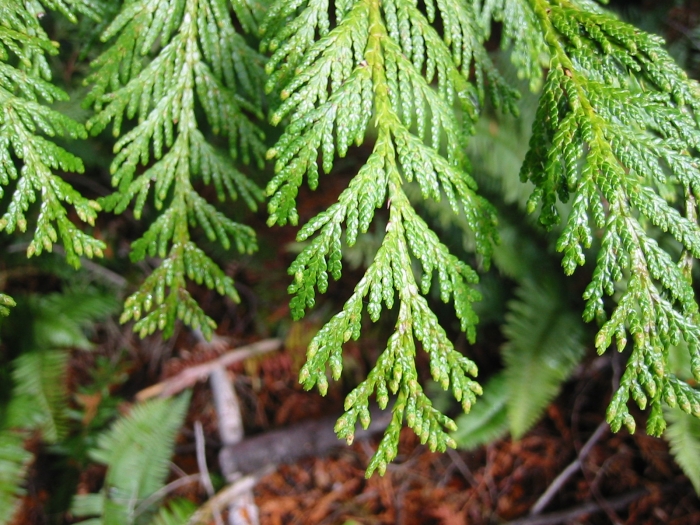Western Redcedar
(Thuja plicata)
Western Redcedar (Thuja plicata)
/
/

Walter Siegmund (talk)
CC BY 2.5
Image By:
Walter Siegmund (talk)
Recorded By:
Copyright:
CC BY 2.5
Copyright Notice:
Photo by: Walter Siegmund (talk) | License Type: CC BY 2.5 | License URL: https://creativecommons.org/licenses/by/2.5 | Uploader: Wsiegmund | Publisher: Wikimedia Commons | Title: Thuja_plicata_7484.jpg | Notes: [[Commons:Batch_uploading/AucklandMuseumCCBY|Auckland Museum]] Page 340.1 Object #34000 AK375782 Image 1/2 http://api.aucklandmuseum.com/id/media/v/707198 |









































































Estimated Native Range
Summary
Thuja plicata, commonly known as Western Redcedar, is an evergreen tree native to moist forests and wetlands of the Pacific Northwest, including Northwestern USA and Canada. It is a large to very large tree, typically ranging from 45 to 70 meters (150 to 230 ft) tall with a trunk diameter of 2.4 to 7 m (8 to 23 ft). In open areas, the crown may reach the ground, while in dense stands, crowns are restricted to the top of the tree. The trunk base is characteristically swollen, and the shallow root system can lead to windthrow in saturated soils. The bark is thin, gray-brown, and fissured into vertical strips. With age, the upper part of the tree can become damaged by wind, resulting in the development of multiple leaders.
Western Redcedar is valued for its durable, rot-resistant wood and aromatic foliage. It is widely used for creating screens and hedges due to its dense foliage and fast growth rate. The tree is also appreciated for its ornamental qualities, with a variety of forms, sizes, and colors available in cultivation. It prefers full sun to part shade, medium water, and well-drained soils. While generally low-maintenance, it can suffer from root rot in poorly drained conditions and may be susceptible to foliage diseases like leaf blight. It is also important to note that Thuja plicata can become invasive when planted outside of its native range, so care should be taken to monitor its spread.CC BY-SA 4.0
Western Redcedar is valued for its durable, rot-resistant wood and aromatic foliage. It is widely used for creating screens and hedges due to its dense foliage and fast growth rate. The tree is also appreciated for its ornamental qualities, with a variety of forms, sizes, and colors available in cultivation. It prefers full sun to part shade, medium water, and well-drained soils. While generally low-maintenance, it can suffer from root rot in poorly drained conditions and may be susceptible to foliage diseases like leaf blight. It is also important to note that Thuja plicata can become invasive when planted outside of its native range, so care should be taken to monitor its spread.CC BY-SA 4.0
Plant Description
- Plant Type: Tree
- Height: 150-200 feet
- Width: 15-25 feet
- Growth Rate: Slow
- Flower Color: N/A
- Flowering Season: Non-Flowering
- Leaf Retention: Evergreen
Growth Requirements
- Sun: Full Sun, Part Shade
- Water: Medium
- Drainage: Medium
Common Uses
Bird Garden, Border Plant, Butterfly Garden, Deer Resistant, Drought Tolerant, Erosion Control, Fragrant, Hedges, Potted Plant, Rabbit Resistant, Rock Garden, Salt Tolerant, Water Garden
Natural Habitat
Moist forests and wetlands of the Pacific Northwest
Other Names
Common Names: Giant Arborvitae, Western Red Cedar, Pacific Red-Cedar, Canoe-Cedar, Giant-Cedar, Western Arborvitae, Western Red-Cedar, Shinglewood, British Columbia Red Cedar, Canoe Cedar
Scientific Names: , Thuja plicata, Thuja plicata f. atrovirens, Thuja gigantea, Thuya plicata, Thuja menziesii, Thuja lobbii, Thuja plicata f. fastigiata, Thuja asplenifolia, Thuja lycopodioides
GBIF Accepted Name: Thuja plicata Donn ex D.Don